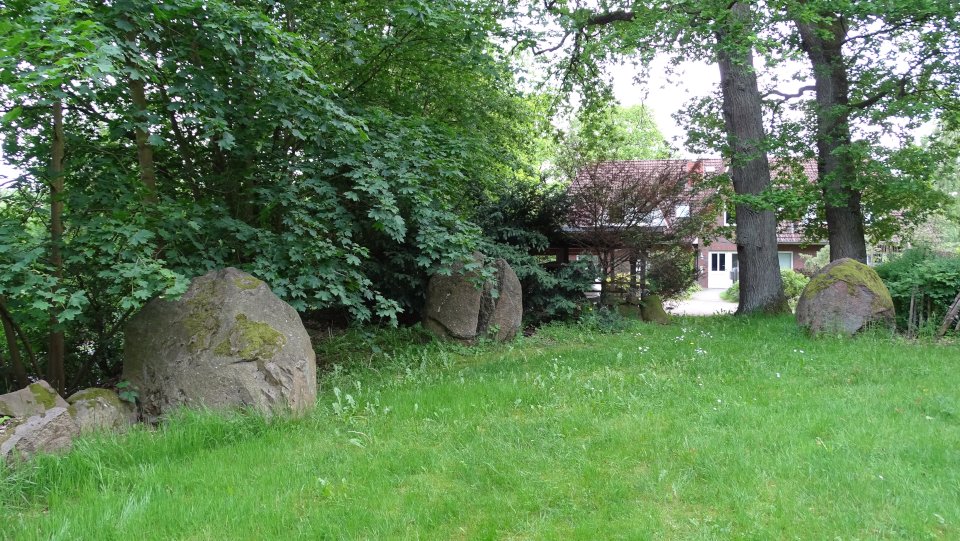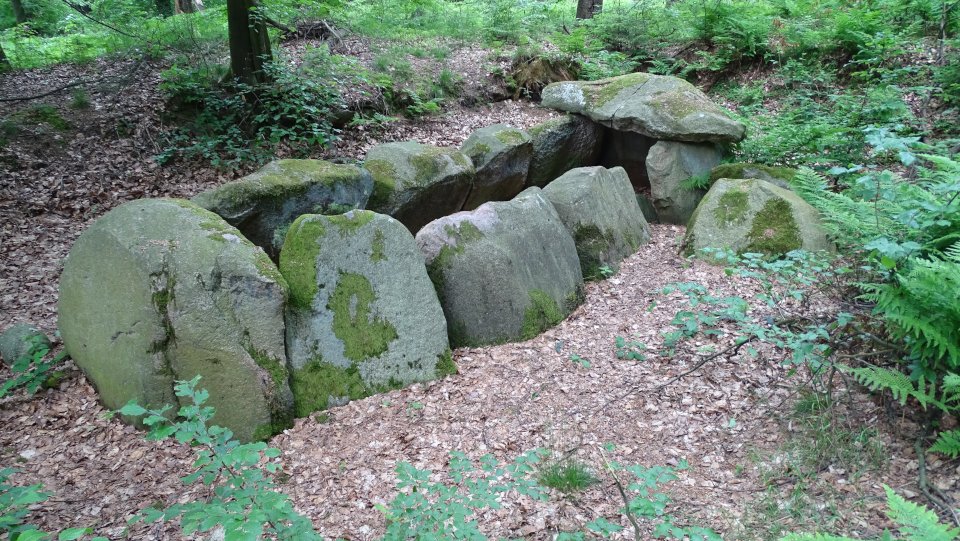





From this once exceptionally large site today only a modest remainder left. During the record by Ernst Sprockhoff in 1967, only three enclosure stones of the southwestern long side and the western cornerstone of the northwestern narrow side were found in situ. Another in situ stone is walled in the corner of a house. Three other stones are no longer in their original position, one is split. According to a report from 1813, the tomb had a northwest-southeast oriented hunebed 70 meters long and 5.4 meters wide. Of the enclosure were still 34 stones available, which corresponded to less than a quarter of the original inventory. The burial chamber was 11 meters from one end of the hunebed. It had a length of 10.5 m, a width of 2.4 m and a height of 1.75 m and was a so-called Emsland chamber consited of 15 support stones and four capstones.
The tomb lies nowadays in the driveway of two family homes directly in the village Steinbeck, southwest of the crossing of the B75 and Wenzendorfer Straße. The overall state is poor, so a visit is recommended only for real enthusiasts.
Visited May 2019











An attempt to get this imposing tomb on one single picture
Revisited May 2019
The tomb is located west of Emsen in the Nenndorfer Interessentenforst, just 500 m north of the autobahn A 1.
Although missing all enclosing stones and most of the capstones, nevertheless Nenndorf is a very nice passage grave and all the effort worth finding it. The burial chamber is still deepened in the burial mound, so that one can hardly recognize the grave from the approaching path. The enclosure, from which unfortunately no stones are preserved, was with 55 m length and 8 m width larger than that of Klecken. The burial chamber lies in the southwestern part of the enclosure. It has a length of 5 m, a width of 1.5 m and a height of 1.5 m, all support stones are still in situ. Overall, the chamber has one endstone on the narrow sides and four pairs of support stones on the long sides. Between the two northeastern stones of the southeastern long side is a gap, which is followed by a wall stone pair of the passage. Of the capstones only a fragment was found, which probably belonged to the northeastern capstone.
In Emsen from the K13 take the Mienenbütteler Weg. After about 500 m you’ll reach a crossing, either park you car here or continue in a southwestern direction for another 600 m (if your car is suitable for this terrain), before you’ll reach the forest. From here a forest path leads in a western direction, walk this path for about 175 m, then turn left to walk for further 275 m in a southern direction. You’ll reach a T-crossing, turn right here. Walk for 325 m on the path, after that look out for the mound, which is only 30 m north of this path.
Highly recommended if your in this area.
Visited May 2019







The site has a flat, round hill bank. In it are the remains of the northwest-southeast oriented burial chamber. In situ are still the northwestern endstone and five support stones of the northeastern long side, of which the middle one, however, is slightly shifted inwards, as an overturned capstone rests on it. The mighty capstone has some drill holes.
The tomb is located about 90m west of the radio tower Langenrehm under a row of trees at the edge of a field. Coming from Emsen, drive north on the Emsener Dorfstrasse in the direction of Langenrehm. After about 1.5 km you reach a crossroads, here you turn right into the street Am Hamboken. Follow this road for about 280 m, before turning left onto the street Diekkoppel into a residential area. Here you park the car and follow the road to the north on foot. After about 110m the road ends, a dirt road leads then between the houses and a paddock around a field directly to the grave.
Visited May 2019
taken from the on-site information board:
Megalithic tomb from the Neolithic Emsen-Langenrehm
Around 5,500 years ago – and thus long before the construction of the pyramids – the custom was spreading among the people of northern Germany to bury the dead in megalithic tombs. These sites were used repeatedly and over a longer period of time as a tomb.
The Hohe Stein (High Stone) at Langenrehm is a so-called passage grave: it had on one side an access, through which you got into the burial chamber originally covered with a mound. The grave was destroyed long ago by stone seekers, who smashed the large boulders and processed into building material. The small, long oval depressions that run in two rows over the many tonne capstone are typical signs that someone had tried to break this boulder with iron wedges.
Excavations in 1931 and 1934 were used to recover some finds from the grave. These are stone utensils and tomb ceramics from around 3200 BC.
For thousands of years, megalithic tombs were the only permanently visible structures in the landscape and therefore always had a great effect on people.
Around 2000 BC the Hohe Stein was used a second time by people who also buried their relatives here. Finally, between 500 BC and Christ’s birth the deceased were buried a third time in the mound that covered the burial chamber.


Some drill holes on the remaining capstone
Visited May 2019





Some stones are lying outside the chamber. Sprockhoff guessed that they belonged to a passage.
Visited May 2019


This tomb is in rather poor condition. A mound is not visible. The burial chamber is probably oriented northeast-southwest, three support stones and a capstone have been preserved.
The tomb is located in a private garden, so I just could take some pictures from a road nearby.
The site is located on the outskirts of Buxtehude in the Altkloster district at the point where the street Am Klöterbusch leads into the entrance to the grounds of a riding hall.
Visited May 2019


The complex consists of four large long barrows, each containing an extended dolmen transversely to the longitudinal axis. A fifth long barrow was still present in the 19th century.
The four enclosures of medium length are located west of the village, (direction Bliedersdorf) in a light beech grove called the Dohrn. Their borders are still largely complete. The extended dolmen originally had two capstones, but are only preserved at Bliedersdorf 1 and Bliedersdorf 4. One capstone is missing from Bliedersdorf 2 and both are missing from Bliedersdorf 3. The tombs Bliedersdorf 1, Bliedersdorf 2 and Bliedersdorf 3 are located in a northwest-southeast aligned row, while Bliedersdorf 4 is offset by 30 meters parallel southeast next to it. The triple formation has a total length of about 120 meters. The entrances to Bliedersdorf 3 and Bliedersdorf 4 are in the northeast, the other two in the southwest.
Currently the forest in which the tombs are located is unfortunately closed and access is forbidden, as several of the up to two hundred and fifty-year-old beech trees threaten to fall down.
But overall this is a mystical places with a lot of aura and atmosphere. Hopefully, the forest owners will soon find a way to make this place worth seeing again to the public.
Drive on the K26 from Hohebrugge to Grundoldendorf. Immediately at the entrance to the village, a road on the left leads northwest to Bliedersdorf. After about 250m you’ll reach a small wood with a parking lot in the bend of the road. The tombs are located in this small wood.
Visited May 2019
Bliedersdorf 1 is a very well preserved long barrow of 51 meters lenght and 8 meters width. Almost all stones are present and are in situ. The stones on the narrow sides are larger than those of the long sides. In the middle of the enclosure there is a chamber with two support stones transverse to the longitudinal direction. It can be considered an extended dolmen. Their dimensions are about 3 x 1.2 meters. The access is in the southwest. Immediately northwest with a gap of only 3 meters, the tomb Bliedersdorf 2 connects.
Visited May 2019
Bliedersdorf 2 is well preserved. Some stones of the enclosure are missing, some more are slightly shifted. The dimension is 28 x 6 meters. The chamber is located slightly northwest of the center of the enclosure. A capstone is still on the stones. The access is in the southwest. Immediately northwest with a gap of only about 3 meters, the tomb Bliedersdorf 3 connects.
Visited May 2019
Bliedersdorf 4 is very well preserved. The length is 39 meters, the width 7 meters. It lacks only a few stones of the enclosure. The chamber is located slightly southeast of the center. It is an extended dolmen of 4 x 2 meters inside. Only a support stone of the chamber is missing. Both capstones are, only slightly shifted, still on. While the tombs 1-3 are located close to each other in a row, Bliedersdorf 4 is offset by 30 meters parallel to the southeast of the other tombs.
Visited May 2019
Bliedersdorf 3 is relatively well preserved, it lacks some stones of the enclosure, some more are slightly shifted. The dimension is approximately 30 x 6 meters. The chamber is located slightly northwest of the center of the enclosure. The support stones of the chamber are all still present, but all capstones are missing. The size of the chamber is approximately 3 x 1.5 meters.
Visited May 2019

Currently the forest in which the tombs are located is closed, as several of the up to two hundred and fifty-year-old beech trees threaten to fall down.
Visited May 2019





